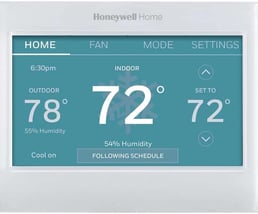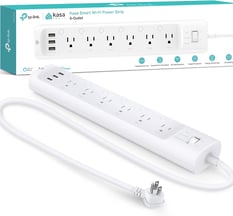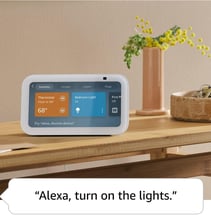How to Set Up a Green Home Office with Smart Technology
A green home office not only reduces your carbon footprint but also enhances productivity and saves money. By integrating smart technology, you can create an energy-efficient, eco-friendly workspace without compromising on convenience.


Working from home has become the new norm, but have you considered how your home office impacts the environment? A green home office not only reduces your carbon footprint but also enhances productivity and saves money. By integrating smart technology, you can create an energy-efficient, eco-friendly workspace without compromising on convenience.
In this guide, we'll walk you through setting up a sustainable home office using smart devices and energy-efficient practices to make your workspace greener and smarter.
Heating and cooling your home office can consume a significant amount of energy. Smart thermostats like Nest or Ecobee learn your habits and adjust the temperature accordingly, reducing unnecessary energy use.
Tip: Set your thermostat to 68°F (20°C) in winter and 78°F (25°C) in summer for maximum efficiency.
Why a Green Home Office Matters
Replace traditional bulbs with smart LED lights that consume up to 80% less energy. Brands like Philips Hue or LIFX allow you to control lighting via your smartphone and even set schedules to avoid wasting electricity.
Tip: Use motion sensors to automatically turn lights on and off when you enter or leave the room.
Step 2: Use Sustainable and Eco-Friendly Office Equipment
Step 4: Automate and Monitor Energy Usage
How to Set Up a Green Home Office with Smart Technology
Step 3: Improve Air Quality and Reduce Waste
Step 1: Choose Energy-Efficient Smart Devices
Energy Star-Certified Devices
Look for Energy Star-rated computers, monitors, and printers. These devices are designed to use less energy while delivering the same high performance.
Tip: Laptops typically use 80% less energy than desktops—opt for one if possible!
Eco-Friendly Furniture and Materials
A green office isn’t just about electronic it’s also about sustainable materials:
• Choose desks and chairs made from reclaimed wood or bamboo.
• Use non-toxic paint and natural fibre rugs to avoid harmful chemicals.
Tip: Check out Fully and Herman Miller for ergonomic and sustainable furniture options.
Paperless and Cloud-Based Solutions
Add Air-Purifying Plants
Indoor plants not only improve air quality but also boost productivity and reduce stress. Some of the best air-purifying plants include:
•Snake Plant – Removes toxins and requires minimal care.
•Peace Lily – Great for filtering indoor air.
•Aloe Vera – Absorbs pollutants while being easy to maintain.
Reduce Electronic Waste (E-Waste)
Dispose of old electronics responsibly. Many stores, such as Best Buy and Apple, offer electronics recycling programs.
Sustainable Swap: Buy refurbished or second-hand tech to reduce environmental impact..
Improve Natural Light & Ventilation
•Open windows for fresh air circulation instead of relying on air purifiers.
•Position your desk near natural light sources to reduce the need for artificial lighting during the day.
Install smart plugs like Wemo or Gosund to track energy consumption and turn off devices remotely.
Tip: Use energy-monitoring systems like Sense Energy Monitor to get real-time data on your electricity usage.
Smart assistants like Amazon Alexa, Google Assistant, or Apple HomeKit can help automate your office setup. Set routines to:
•Turn off all office lights and devices when leaving the room.
•Adjust temperature settings throughout the day.
•Remind you to take breaks and stretch!
Creating a green home office doesn’t have to be overwhelming. Start small—switch to smart lighting, upgrade to an Energy Star-certified laptop, or simply add a snake plant to your desk. Each step reduces your carbon footprint while enhancing productivity and well-being.
By integrating smart technology, you not only make your office energy-efficient but also save money on electricity bills in the long run.
Subscribe to our newsletter
Smart Thermostats for Optimal Climate Control
Smart LED Lighting
Smart Power Strips
Did you know that even when turned off, electronic devices still consume energy? Smart power strips cut off power to devices when they’re not in use, preventing "phantom energy" waste.
Tip: Try TP-Link Kasa Smart Power Strip or Belkin Conserve to automate and control multiple devices with one app.
Minimise waste by going paperless. Instead of printing documents, use cloud storage services like Google Drive, Dropbox, or OneDrive.
Tip: If you must print, use recycled paper and set your printer to double-sided printing by default.
Smart Plugs and Energy Monitoring Systems
Automate Your Work Routine with Voice Assistants
FAQs: Green Home Office & Smart Technology
1. How much energy can I save with a green home office?
By using smart technology and energy-efficient devices, you can cut your energy usage by up to 30%, depending on your habits and office setup.
2. Are smart devices expensive?
While smart devices have an initial cost, they pay off over time through lower energy bills and increased efficiency.
3. What’s the best eco-friendly office desk material?
Look for desks made of bamboo, reclaimed wood, or recycled materials. Brands like Herman Miller offer sustainable options.
4. How can I make my home office completely paperless?
Use cloud storage, digital note-taking apps (Evernote, OneNote), and e-signature services like DocuSign to eliminate the need for paper.
5. Can smart home automation really help the environment?
Yes! Automating lights, heating, and energy usage reduces waste and ensures you only consume what’s necessary.
Let's Connect
Sign up to the newsletter
© 2025. All rights reserved.








